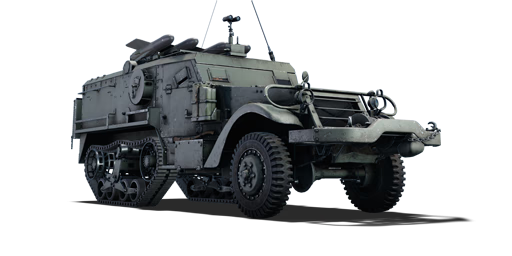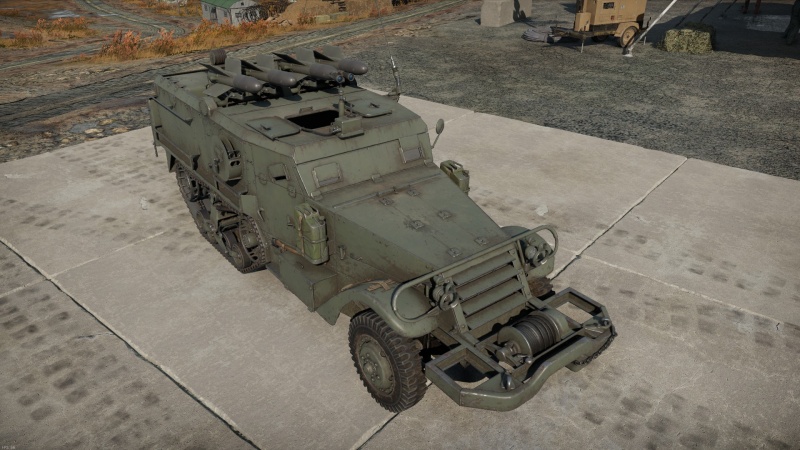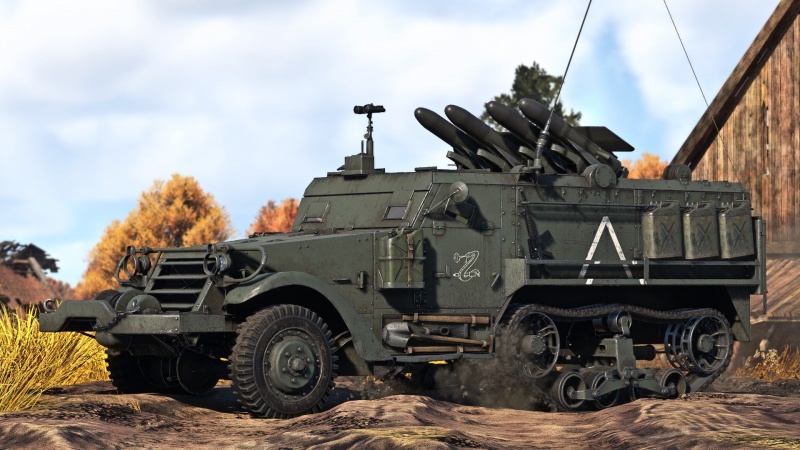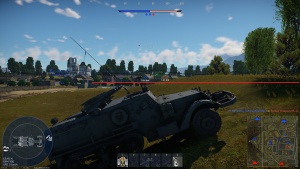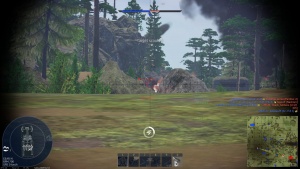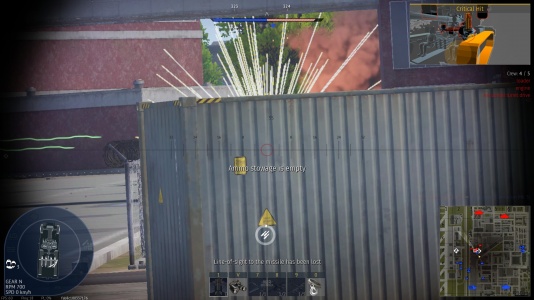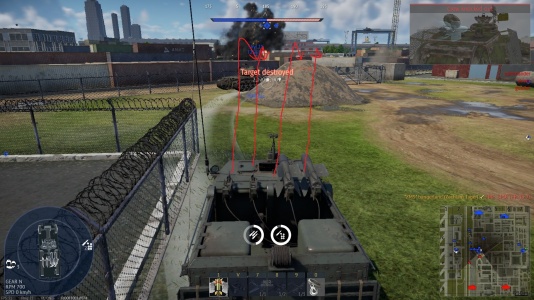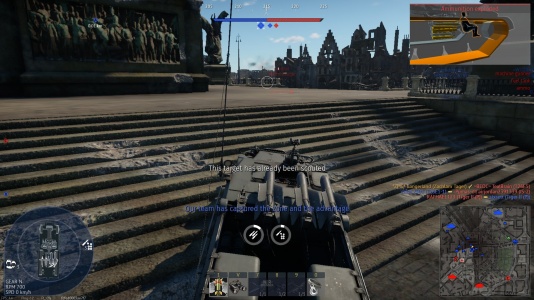Zachlam Tager
Contents
Description
During the IDF arming process during the 1948 Arab-Israeli War, the IDF employed several American half-tracks as their main APCs. Vehicles like the M2, M3, M5, and M9 were acquired from different sources. Many were adapted for different purposes, like the TCM-20 SPAA. With the introduction of the French SS.11 ATGM in the 1950s (locally designated "Tager"), it was decided to use the abundant American half-tracks for anti-armour purposes. Even though they were somewhat obsolete by then, they saw most of their action during the Six-Day War of 1967 against T-54s. However due to a lack of doctrinal knowledge in of ATGM usage, many Tagers were ignored during the conflict, and it is not clear if any scored kills.
Introduced in Update "Wind of Change", the Zachlam Tager's Tager missiles have, like most early ATGMs, uncomfortable controls and very slow speed. However, they do pack a heavy punch, and it should be used with its advantages and weaknesses in mind. Since the Zachlam Tager is fast, it can reach objectives faster than most MBTs, and then hide in well-camouflaged positions and strike any enemy that tries to take back the area with missiles. The missiles are slow and have a lot of inertia in their movements, thus, calm and steady changes of course are recommended instead of drastic changes of direction. The ideal range for missile shots in flat ground, is around 200-600 m, since less than 300 m may result in poor handling and more than 600 m is hard to hit because the missiles are very slow and many tanks can shoot them down with their machine guns.
General info
Survivability and armour
The armour on this half-track is negligible, as it can be penetrated from every side by a 7.62 machine gun under 400 m range. The front could resist light machine guns, but the driver and gunner windows can be penetrated regardless, disabling the carrier instantly. On top of that, the truck is open-topped, which means if it's hit by any chemical shell anywhere, or another tank explodes right behind it, the crew is doomed. The side shielding is so poor, that the carrier can be sometimes overpressured even by a machine gun.
This also makes the hull less vulnerable to APHE, as sometimes even some of the most sensitive shells will fail to detonate upon hitting it. Unfortunately, even a glancing hit will almost always take out two crew members, so it is usually only relevant in AB after researching "Crew Replenishment". The top panels and missiles themselves are thick enough to detonate APHE and AP-I of autocannon belts, so it is better to not expose the ammo racks during hull-down battles.
There are also two spare missiles in the back of the truck, hidden within ammo crates that are 6.35 mm RHA thick and may not explode if hit indirectly, but burn instead.
The truck is short enough to hide behind many medium tanks and cover, though the weapons and the very top of the hull is generally exposed, which makes it unreliable in AB and it is impossible to use sniper scope when hiding behind such objects.
The binocular on top of the vehicle cannot be targeted by AB aim assist or hit, but will make it visible. This is most relevant when fighting artillery tanks, as they can use HE-VT to shell Zachlam from almost anywhere, even if any other tank can't touch it.
Armour type:
| Armour | Front (Slope angle) | Sides | Rear | Roof |
|---|---|---|---|---|
| Hull | ___ mm | ___ mm Top ___ mm Bottom |
___ mm | ___ - ___ mm |
| Turret | ___ - ___ mm Turret front ___ mm Gun mantlet |
___ - ___ mm | ___ - ___ mm | ___ - ___ mm |
| Cupola | ___ mm | ___ mm | ___ mm | ___ mm |
Notes:
Mobility
Zachlam Tager
is very fast when moving forward in a straight line, even competing with light tanks when spaded. Unfortunately, it has a poor reverse, so it's significantly less mobile than RakJPz 2 and the operator must commit to their fights or be destroyed.
The Zachlam is both a wheeled and tracked vehicle; it heavily suffers from the downsides of both types until all upgrades are researched - it can't turn well in place due to the wheels and will outright refuse to readjust when standing on a hill or in the mud (maximum turn speed of 0.3° a second), and it can't really use roads to accelerate due to the tracks. Carrier also has nearly no mass and does not keep momentum after collisions, so it's best to avoid crashing into obstacles.
The drive wheels are the tracks in the back - the front wheels do not generate any momentum and if the half-track manages to hang itself on some ladder or rocks, it will be forever stuck there, unless the missile launch recoil managed to kick the front of the truck off it.
Until the Zachlam is spaded, it has a general forward speed of 42 km/h in AB and 30-35 km/h in RB. Researching all of the mobility modules together dramatically improves the acceleration, adds another 7 km/h of maximum off-road speed, allows the truck to almost spin in place on flat ground, and enables the ability to use paved roads to reach maximum speed of 70-80 km/h.
The truck barely has enough horsepower to push itself up steep hills, but it will still do so at 5 km/h speed in most cases.
| Game Mode | Max Speed (km/h) | Weight (tons) | Engine power (horsepower) | Power-to-weight ratio (hp/ton) | |||
|---|---|---|---|---|---|---|---|
| Forward | Reverse | Stock | Upgraded | Stock | Upgraded | ||
| Arcade | 83 | 19 | 8.6 | 210 | 282 | 24.42 | 32.79 |
| Realistic | 76 | 18 | 131 | 148 | 15.23 | 17.21 | |
Modifications and economy
Due to the overall fragility of the Zachlam, it is technically possible to skip repair tools entirely. Parts can only be used if the launcher was hit with pure AP or APDS or to repair friendlies (which is generally dangerous to do), and FPE is only usable if ammo racks in the back were hit, but didn't explode, which is very rare. Mobility upgrades have a much higher priority, as being able to reach vantage points allows the truck to never be put in danger of being hit in the first place and being fast enough to reach a fortified capture point first gives it more chances to actually affect the battle in a meaningful way, especially in AB.
Armaments
Main armament
The main weapons are the LFK SS.11 missiles. There is 4 of them on the top of the truck and 2 reserve missiles are stored in the boxes in the very back.
These missiles are wire guided, which means that in RB you will have to guide them with WASD (tank movement inputs) and cannot move the vehicle until they hit a target. In AB, they are guided with the mouse and do not prevent the Zachlam Tager from moving after launching (it is still necessary to stop to fire). These missiles cannot be efficiently cut off to attack multiple targets, as they will immediately drop to the ground if the control signal is lost.
SS.11 missiles have a very long guidance dead zone (about 150 m) in which you cannot really control them, but they are generally more responsive than others. While they are responsive, they also have very high inertia, and when turning horizontally they also tend to drop down, so some care must be taken when guiding or launching them. It is important to avoid situations in which missile must be guided into some sort of a crack inbetween rocks, as even if it's possible to push SS.11 through, the enemy tanks can easily suppress missiles guided straight with their MG.
When launched, the missiles will fly straight for about 70 m, then attempt to turn towards initial sniper crosshairs position. If it's necessary to launch them to the side, launch them upwards, as otherwise they will usually crash to the ground. At melee range, treat them like rockets. After the guidance system activates, it becomes possible to correct their course. Since the truck does not turn well in place and does not turn at all when standing upright, positioning and planning becomes very important.
Missiles fire from the left to the right and reload from the right to the left. Each shot forces a 1 second "reload". The ready rack is reloaded at a rate of 1 missile per 3 seconds, but only when the carrier is not firing (like on the tank autoloaders) or reloading, resulting in atleast 5 seconds wait after firing. If entirety of the ready rack was used, a forced 13 seconds reload penalty is applied after the ready ammo rack reloaded one missile, effectively making the carrier to stop firing and reloading for at least 18-23 seconds. Do note, that ammo rack reload penalty is applied even if capture point or AB mechanics already rearmed ready rack completely.
Rearm on a capture point takes 8 seconds per missile and tends to put missiles straight into missile ready rack. Since reload penalty is applied even if the vehicle rearmed its entire ammo pool in AB, rearm outside of a capture point takes 70 seconds + the forced reload of 13 seconds.
As such, it's optimal to let the Zachlam reload both reserve missiles before the ready ammo rack was completely used up, and should it somehow manage to entrench on a capture point, it's generally better to not use the last missile and to wait 8 seconds until the capture point puts next missile into the ready rack instead of incurring the reload penalty and being forced to wait for 21 seconds. This is also true in AB - even though all 4 missiles are reloaded at the same time while rearming on a capture point from the scratch, the Zachlam cannot fire-and-forget multiple missiles, and it cannot really guide missiles at point blank range, so it's usually detrimental to wait longer.
Unlike with most of the other wire guided missile carriers, it is possible to choose if you want to launch the missile straight forward or upwards. This allows a smart operator to bombard enemy tanks out and over cover and then unload its entire ammo rack when they lose patience and try to rush the position. Keep in mind, the half track must be stationary for missiles to fire, so it is important to prepare for a counter-attack properly.
In AB, the missiles are guided with a binocular on top of the vehicle without dependency on sniper crosshair and can be guided anywhere. Since enemy tanks have aim assist in AB, the most sensible strategy is to only pull out the binoculars out of cover without exposing anything else.
| Be aware, that while arcade mode allows the Zachlam to guide missiles with the mouse, it also restricts control of missiles - if binoculars can't see the target, they will fail to guide the missile. SACLOS also makes them vulnerable to IRCM jamming. If you do not want to deal with indirect fire techniques, to snipe above cover pull tank optics out of cover, so it does not block the space in between camera and target and ensure that you can aim at the target directly without anything else being in the way. |
| Tager missile | Reloading rate (seconds) | ||||||
|---|---|---|---|---|---|---|---|
| Capacity | Vertical | Horizontal | Stabilizer | Stock | Full | Expert | Aced |
| 6 | -5°/+20° | N/A | N/A | 13.00 | 11.50 | 10.60 | 10.00 |
Ammunition
| Penetration statistics | |||||||
|---|---|---|---|---|---|---|---|
| Ammunition | Type of warhead |
Penetration @ 0° Angle of Attack (mm) | |||||
| 10 m | 100 m | 500 m | 1,000 m | 1,500 m | 2,000 m | ||
| LFK SS.11 | ATGM | 600 | 600 | 600 | 600 | 600 | 600 |
| Missile details | ||||||||||||
|---|---|---|---|---|---|---|---|---|---|---|---|---|
| Ammunition | Type of warhead |
Velocity (m/s) |
Range (m) |
Projectile mass (kg) |
Fuse delay (m) |
Fuse sensitivity (mm) |
Explosive mass (TNT equivalent) (kg) |
Ricochet | ||||
| 0% | 50% | 100% | ||||||||||
| LFK SS.11 | ATGM | 220 | 3,500 | 29.99 | 0.05 | 0.1 | 2 | 80° | 82° | 90° | ||
Ammo racks
| Full ammo |
1st rack empty |
2nd rack empty |
3rd rack empty |
4th rack empty |
5th rack empty |
6th rack empty |
Visual discrepancy |
|---|---|---|---|---|---|---|---|
| 6 | __ (+__) | __ (+__) | __ (+__) | __ (+__) | __ (+__) | __ (+__) | __ |
Usage in battles
The Zachlam is technically a very straightforward vehicle to play - you want to occupy any vantage point that protects the hull and hides the missiles, but allows you to aim directly at the enemy. You can even try to use its high speed to rush and bombard enemy team from a relatively short range of 200-250 m. The difficulties come with the numerous drawbacks of the vehicle.
When launching the missile directly forward, the only real concern is to not push it down too quickly, as otherwise it will crash into the ground. While it's possible to launch missiles sideways, they can prove to be too difficult to put back on course due to a heavy inertia in missile movements, so it would still require at least 300-400 m of range to guarantee a decent launch to the side, and there may or may not be any suitable cover.
In any mode, the operator should always remain as cold-blooded as possible and avoid making frantic movements. Knowing which push directions resemble an inescapable tunnel, which cover the Zachlam can hide behind and where to scout for potential targets or countersnipers is half the battle. For example, if an enemy tank would suddenly appear, the truck must be immediately turned as straight to the target as possible and stopped without any additional corrections, then a missile must be fired. If you didn't know someone was coming, it's probably already too late. Even if you did expect them, by panicking you will only give the enemy the necessary split second to start firing an MG, which usually destroys the Zachlam nearly instantly. However, if enemy did not expect you, and you were completely prepared, it's entirely possible to overwhelm at least 2 tanks before dying.
The missiles have extraordinary range, but in practice will almost never reach a far-away target in time due to how slow and moody they are. The sweet spot for a target is between 400 and 600 m, past the 150 m dead zone and within 3 seconds of missile flight time at most. The Zachlam can find limited success in using hills at its advantage, by firing missiles upward and dropping them on enemies from the safety of cover; or at point-blank, without control over the missiles due to the deadzone but with the advantage of being able to fire 4 missiles in rapid succession.
Since SS.11 is a quite fragile missile, it is a decent idea to not guide missile straight at the enemy tank, but slightly to the side until the last 60 m. This makes enemy less likely to just shoot it down and might make some less aware people unlikely to duck back into cover (for example, when they think that they aren't the primary target and don't know that ATGM can very quickly snap onto them.)
There are also certain considerations to be made regarding the 6 missile ammo limit and different missile control schemes in AB/RB. While many attack techniques from AB may also work in RB, they would require far more range, far more practice and will leave not as much room for error, as in AB.
AB tips
Most of the drawbacks of the Zachlam are not present, as such it can be played relatively freely, but avoid directly attacking tanks or provoking any HEAT armed SPG without the safety of a full hulldown, as aim assist makes them borderline invincible for you. Most of APHE tanks are also deadly, so it's generally better to stay low.
If you choose to play safely, you can stand at about 400-600 m range like with sniper tanks, but such playstyle won't net you a lot of hits in AB, because enemy tanks always receive an ATGM alert on their screen whenever you fire at their front. At the very least, you should try to blindside your opponents, or train your ability to judge distance towards the target and guided missiles, so that you can attack them even if they duck back behind a hill. If you get an artillery alert, simply move away as nothing is really at stake with such playstyle.
Even if you have nothing to do, do not forget to constantly look around you and scout enemy tanks, as this will indirectly make your teammates protect you and may give you free assists, which you can use to spawn a bomber to kill time while your launchers rearm.
In some cases, it is possible to use the Zachlam even in a city by hiding behind concrete blocks, containers or dumpsters, as they often hide the hull completely and allow you to scout and guide missiles over them (at least 150 m range is necessary for them to connect). Even an inexperienced operator should manage atleast a 25% hit rate, and in AB it's possible to reload outside of a capture point, so it's a viable tactic. Here are some practical examples:
Ultimately, the Zachlam's full attack potential is realized when standing on a fortified capture point, as it allows it to avoid waiting for 80 seconds to get more missiles and may lead to situations in which enemy team simply cannot move in to attack without an airstrike due to an endless suppressing fire from you. This only works on capture points which can fully protect the hull and missiles, which means that certain capture points, or even certain sides of those capture points are vastly superior to others.
Here are some examples of firing from well protected capture points. Do note, that missile rack should be pointing directly towards the target to reduce a chance of misfiring, and Zachlam must be parked at least 160 m away from opponents. Do not use the last missile to avoid the reload penalty and to continue supressing an enemy team:
Unlike with the stand-off sniping, if enemy team calls artillery strike on you during this, fire off the last missile, let capture point instantly restore your ammo, then retreat. This will allow you to only wait for about 20 seconds instead of 80 before firing again, which means that you don't have to abandon the capture point completely.
RB tips
The Zachlam gets very few options. The safest way to play is simply as a scout, using hills for cover and scouting through the safety of your binoculars, occasionally sniping exposed tanks. Every enemy you encounter is an immense threat, and none is easy to destroy: even light vehicles may dodge or shoot down your missiles. You can only stay close to strategic points with the 6 missiles, and if none of the strategic points are in your team's control, there is simply nothing the Zachlam can do besides staying low and passively scouting.
Notable enemies
HEAT-wielding tanks - Any tank armed with a HEAT launcher like the familiar M-51 is a threat to the Zachlam due to the ability to drop shells from a much higher angle than other tanks and no need to swap away from kinetic ammunition. Since the truck is open-topped, even a close miss might obliterate it. Make sure to duck further into cover when fighting these, especially in AB.
HE-wielding tanks - An even worse idea is to annoy dedicated artillery tanks like the 2S3M or Type 75 SPH. Not only their users have much more experience with indirect fire than others, but most of such tanks also have HE-VT shells, which can explode above you, given the Zachlam no chance to retreat if you get in their way.
Pros and cons
Pros:
- Has four missiles ready to fire
- Missiles are loaded and armed quickly if the ready rack is not expended
- Has significantly better maximum range than other missile carriers
- Missiles can deal significant damage to targets, especially if the explosion detonates ammo racks or fuel tanks
- Can attack both directly and indirectly depending on the terrain and range
- Relatively small profile and sight position allows this vehicle to stay low when hull down
- Zachlam chassis is highly maneuverable with a high top speed when modified
- Has access to scouting, which is especially useful if the vehicle runs out of missiles
- Unassuming truck-like profile may trick enemies into ignoring the vehicle in urban environments
- Missile can be guided without using the sniper sight in AB mode
Cons:
- Has very light armour and is open topped which makes this vehicle very vulnerable to enemy fire, artillery, and enemy aircraft
- Cannot fire on the move
- Relatively low ammunition count
- Slow reload penalty if the entire ready rack is fired too quickly
- Controls have a dead zone of ~150 m, which combined with launch/reload patterns makes fighting in cramped spaces difficult
- The missile's relatively slow speed can lead to a miss if the target is far away or moves and also allows a chance for the enemy to shoot it down
- Missiles can detonate prematurely on obstacles such as walls and trees
- Does not have horizontal traverse for its launcher which means the whole vehicle must be turned towards the direction of the target
- No secondary armament can force the vehicle out of combat if all missiles are expended
- Half-track chassis may get permanently stuck if driven carelessly into poor terrain
- Tall radio antenna can lead to the vehicle being spotted early by vigilant enemies
- Manual missile controls in RB and SB modes can be difficult to learn
History
As part of its armament process leading up to and during the 1948 War of Independence, the armoured corps of the Israeli Defense Force (IDF) acquired a large number of WW2 surplus M2, M3, M5 and M9 halftracks from a variety of sources. These vehicles rapidly became the IDF's primary armoured personnel carriers for mechanized infantry units, and participated in every Israeli war until their eventual replacement by the M113.
While the Allies had experimented with a variety of different weapon mounts for these halftracks during the war, Israel continued to do so in the late 1940s and early 1950s, mostly using French and locally-produced weapons. Halftracks with cannons, howitzers and mortars became commonplace, and were used as fire support for both armoured units and mechanized infantry units.
The development of the French SS.11 anti-tank guided missile in the 1950s greatly intrigued the Israelis, and they decided to acquire large quantities of the weapon system. Among other implementations, Israeli military industries experimentally mounted the weapon on M3 halftracks. Four rails were installed, each carrying a missile ready to launch. The Israelis gave the SS.11 the codename Tagar ("Provocateur"), which is misspelled as "Tager" in War Thunder. The full name Zachlam Tagar means "Tagar Half-track". The vehicles were deployed as part of the IDF's artillery corps, organized into multiple batteries, and attached to various armoured and mechanized regiments.
The Tagar's primary action was during the 1967 Six-Day War, where it was mostly meant to engage Syrian and Egyptian T-54s. Tagars were thus possibly the first guided missile tank-destroyers ever to be used in actual combat. Unfortunately for the Israelis, their doctrine for the tactical application of high-mobility ATGM platforms was practically non-existent, resulting in the weapon being almost completely ignored by the armoured unit commanders, and being deployed sub-optimally in most battles where its was present. However, they reportedly did fire at enemy targets during the initial push into the Syrian Golan Heights, as well as during the battle of Abu-Ageila which directly paved the way to the Israeli takeover of the entire Sinai peninsula from Egypt. It is unclear whether the Tagars scored any kills during their engagements.
The Tagars were soon decommissioned following the Six-Day War. By the time the importance of ATGMs in modern warfare had become clear, Israel was already well on its way to replacing most of its halftracks with M113s.
Media
- Skins
See also
Vehicles of similar design or capabilities
Vehicles with the same chassis
External links
| Israeli Ordnance Corps (חיל החימוש) | |
|---|---|
| Medium Tanks | M-51 · M-51 (W) |
| MBTs | |
| Magach | Magach 1 · Magach 2 · Magach 3 · Magach 3 (ERA) · ▃Magach 3 (ERA) · Magach 5 |
| Magach 6 · Magach 6A · Magach 6B · Magach 6C · Magach 6R · Magach 6M · Gal Batash | |
| Sho't | Sho't · Sho't Kal Alef · Sho't Kal Gimel · Sho't Kal Dalet · ▄Sho't Kal Dalet |
| Tiran | Tiran 4 · Tiran 4S |
| Merkava | ▃Merkava Mk.1 · Merkava Mk.1B · Merkava Mk.2B · ▃Merkava Mk.2B · Merkava Mk.2D |
| Merkava Mk.3B · Merkava Mk.3C · ▃Merkava Mk.3D · Merkava Mk.4B · Merkava Mk.4M | |
| Tank destroyers | Zachlam Tager |
| See Also | Chrysler Defense · Department of Tank Design · Morozov Design Bureau |
| Israel tank destroyers | |
|---|---|
| Artillery | M109 · Rochev · Sholef |
| ATGM | Zachlam Tager · Giraf |


